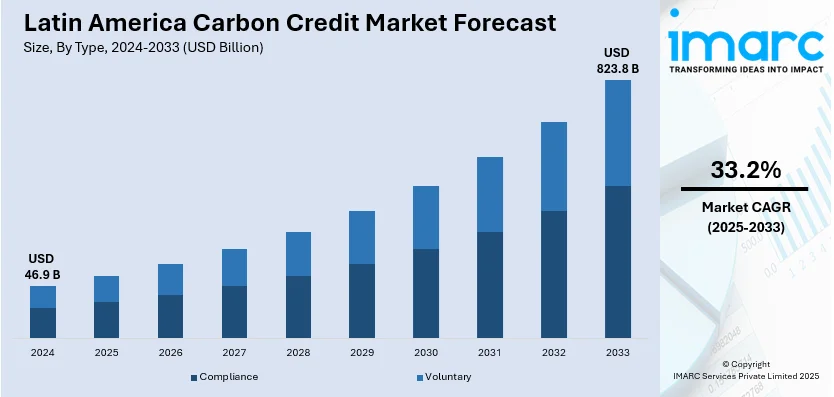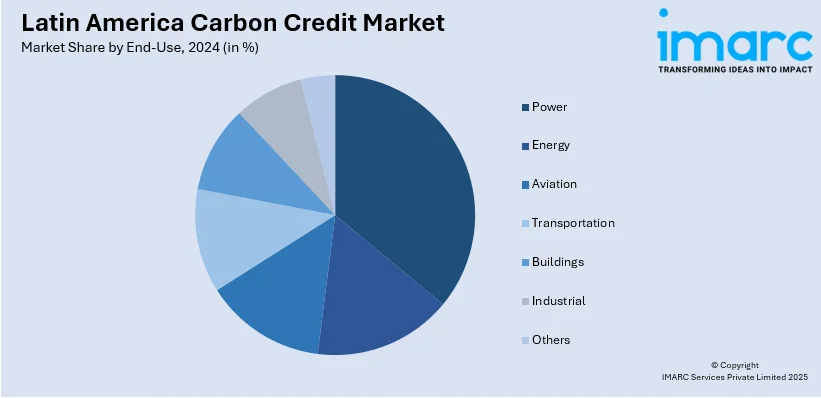
Latin America Carbon Credit Market Size, Share, Trends and Forecast by Type, Project Type, End-Use, and Region, 2025-2033
Latin America Carbon Credit Market Overview:
The Latin America carbon credit market size reached USD 46.9 Billion in 2024. Looking forward, IMARC Group expects the market to reach USD 823.8 Billion by 2033, exhibiting a growth rate (CAGR) of 33.2% during 2025-2033. Legislative frameworks, corporate net-zero pledges, international carbon trading systems, escalating deforestation concerns, and investments in nature-based solutions are the factors propelling the growth of the market. Government policies, voluntary carbon markets, and rising demand for certified offsets are fueling the market.
|
Report Attribute
|
Key Statistics
|
|---|---|
|
Base Year
|
2024
|
|
Forecast Years
|
2025-2033
|
|
Historical Years
|
2019-2024
|
| Market Size in 2024 | USD 46.9 Billion |
| Market Forecast in 2033 | USD 823.8 Billion |
| Market Growth Rate (2025-2033) | 33.2% |
Latin America Carbon Credit Market Trends:
Rising Demand for Large-Scale Carbon Offset Agreements
There is a rise in long-term commitments to nature-based solutions, indicating a trend toward large-scale carbon offset purchasing. Organizations are entering into multiyear agreements to get verified credits, with an emphasis on forestry and land restoration initiatives. Investments in forestry programs not only reduce emissions but also help to conserve biodiversity and boost local economies. Financial institutions play a vital role in facilitating these transactions, which correspond with global sustainability objectives. Latin America is growing as a major source of high-quality carbon credits, aided by legal frameworks and business sustainability goals. As the need for reliable offsets increases, more long-term agreements are expected, increasing reliability in nature-based carbon removal technologies. For example, in September 2024, Meta entered an agreement to purchase up to 3.9 million carbon offset credits from the forestry division of Brazilian investment bank BTG Pactual, with the transaction set to continue through 2038.

Expanding Investment in Large-Scale Carbon Removal Initiatives
The carbon credit market in Latin America is witnessing increased investment in large-scale nature-based solutions, with a focus on long-term carbon removal agreements. Companies are establishing multi-year agreements to offset emissions, with an emphasis on reforestation and land restoration initiatives. Financial institutions and investors are investing heavily in forestry projects to help achieve the worldwide net-zero target. These initiatives not only help to reduce carbon emissions, but they also improve biodiversity and aid local economies. Regulatory backing and rising business demand for high-integrity removal credits are propelling the growth of such programs. The transition to certified carbon removal options emphasizes the region's potential as a significant provider of high-quality offsets, with long-term contracts supporting trust in nature-based climate mitigation activities. For instance, in June 2024, BTG Pactual Timberland Investment Group (TIG) committed to supply Microsoft with up to 8 Million nature-based carbon reduction credits by 2043. This is the greatest carbon dioxide elimination credit transaction to date. The credits would come from TIG's USD 1 Billion forestry and restoration programs in Latin America, which aim to reduce climate change while increasing biodiversity and benefitting local people.
Latin America Carbon Credit Market Segmentation:
IMARC Group provides an analysis of the key trends in each segment of the market, along with forecasts at the region/country level for 2025-2033. Our report has categorized the market based on type, project type, and end-use.
Type Insights:
- Compliance
- Voluntary
The report has provided a detailed breakup and analysis of the market based on the type. This includes compliance and voluntary.
Project Type Insights:
- Avoidance/Reduction Projects
- Removal/Sequestration Projects
- Nature-based
- Technology-based
A detailed breakup and analysis of the market based on the project type have also been provided in the report. This includes avoidance/reduction projects and removal/sequestration projects (nature-based and technology-based).
End-Use Insights:

- Power
- Energy
- Aviation
- Transportation
- Buildings
- Industrial
- Others
A detailed breakup and analysis of the market based on the end-use have also been provided in the report. This includes power, energy, aviation, transportation, buildings, industrial, and others.
Regional Insights:
- Brazil
- Mexico
- Argentina
- Columbia
- Chile
- Peru
- Others
The report has also provided a comprehensive analysis of all the major regional markets, which include Brazil, Mexico, Argentina, Columbia, Chile, Peru, and others.
Competitive Landscape:
The market research report has also provided a comprehensive analysis of the competitive landscape. Competitive analysis such as market structure, key player positioning, top winning strategies, competitive dashboard, and company evaluation quadrant has been covered in the report. Also, detailed profiles of all major companies have been provided.
Latin America Carbon Credit Market News:
- In February 2025, indigenous and local organizations from Central and South America proposed recommendations to the Architecture for REDD+ Transactions (ART) to improve the openness and inclusion of jurisdictional carbon market regulations. These ideas are intended to promote indigenous rights, provide free, prior, and informed consent, and improve fair benefit-sharing arrangements. Proper implementation may close an estimated USD 4.1 Trillion nature funding shortfall by 2050, benefiting both communities and the environment.
- In September 2024, Meta agreed to buy up to 3.9 Million carbon offset credits from BTG Pactual's forestry segment by 2038. This transaction, which might be worth USD 16 Million, helps Meta achieve its target of net-zero emissions by 2030. The credits are derived from BTG Pactual's reforestation efforts in Latin America, where more than 7 million seedlings have been planted.
Latin America Carbon Credit Market Report Coverage:
| Report Features | Details |
|---|---|
| Base Year of the Analysis | 2024 |
| Historical Period | 2019-2024 |
| Forecast Period | 2025-2033 |
| Units | Billion USD |
| Scope of the Report |
Exploration of Historical Trends and Market Outlook, Industry Catalysts and Challenges, Segment-Wise Historical and Future Market Assessment:
|
| Types Covered | Compliance and Voluntary |
| Project Types Covered |
|
| End-Uses Covered | Power, Energy, Aviation, Transportation, Buildings, Industrial, and Others |
| Regions Covered | Brazil, Mexico, Argentina, Columbia, Chile, Peru, and Others |
| Customization Scope | 10% Free Customization |
| Post-Sale Analyst Support | 10-12 Weeks |
| Delivery Format | PDF and Excel through Email (We can also provide the editable version of the report in PPT/Word format on special request) |
Key Questions Answered in This Report:
- How has the Latin America carbon credit market performed so far and how will it perform in the coming years?
- What is the breakup of the Latin America carbon credit market on the basis of type?
- What is the breakup of the Latin America carbon credit market on the basis of project type?
- What is the breakup of the Latin America carbon credit market on the basis of end-use?
- What are the various stages in the value chain of the Latin America carbon credit market?
- What are the key driving factors and challenges in the Latin America carbon credit?
- What is the structure of the Latin America carbon credit market and who are the key players?
- What is the degree of competition in the Latin America carbon credit market?
Key Benefits for Stakeholders:
- IMARC’s industry report offers a comprehensive quantitative analysis of various market segments, historical and current market trends, market forecasts, and dynamics of the Latin America carbon credit market from 2019-2033.
- The research report provides the latest information on the market drivers, challenges, and opportunities in the Latin America carbon credit market.
- Porter's five forces analysis assist stakeholders in assessing the impact of new entrants, competitive rivalry, supplier power, buyer power, and the threat of substitution. It helps stakeholders to analyze the level of competition within the Latin America carbon credit industry and its attractiveness.
- Competitive landscape allows stakeholders to understand their competitive environment and provides an insight into the current positions of key players in the market.
Need more help?
- Speak to our experienced analysts for insights on the current market scenarios.
- Include additional segments and countries to customize the report as per your requirement.
- Gain an unparalleled competitive advantage in your domain by understanding how to utilize the report and positively impacting your operations and revenue.
- For further assistance, please connect with our analysts.
 Inquire Before Buying
Inquire Before Buying
 Speak to an Analyst
Speak to an Analyst
 Request Brochure
Request Brochure
 Request Customization
Request Customization




.webp)




.webp)












